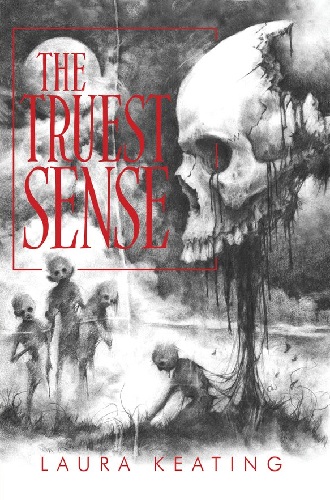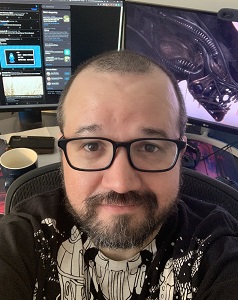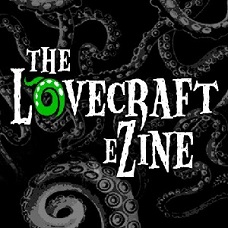Welcome back to my author interview series. Many thanks to Laura Keating for taking some time to answer these questions. After you’re done reading this interview, why not check out my early review of her latest work, The Truest Sense? Without further ado, let’s get to the discussion.

1. What made you start writing horror?
I’ve always loved horror, but I forgot that for a while. When I started writing as a teenager, I wrote what I was reading mostly at the time: fantasy & sci-fi. The stories went nowhere. When I was in my mid-twenties, I was going through a challenging period in my life. I was working as a waitress and one day, fresh off the lunch shift, as I walked around downtown Fredericton to kill time until my ride could take me home, I decided I wanted a new author to read, someone with a lot of work out so I could binge their catalogue. I went into The Owl’s Nest (RIP to the best used bookstore there ever was) and found a whole shelf of Stephen King books. I’d read two before: Carrie and The Gunslinger and had loved both. I bought The Shining and ‘Salem’s Lot with some of the tips I’d made that day. I blew through those books. It was like a bomb went off in my brain and the fallout was remembering how much I’d LOVED spooky horror as a kid (Are You Afraid of the Dark, Tales from the Crypt Keeper, everything Halloween) – until I’d been mocked in middle school for being ‘morbid’ and had shoved that passion away. I started reading/watching all the horror classics I could get ahold of from the library & Owl’s Nest. I abandoned the YA fantasy novel I’d been writing and started on a new horror short story, something I’d never done before. “We Are Giants” got published for fifty bucks – but it was fifty dollars more than I’d ever made from writing in my life. I never looked back.
2. What is your favorite tool (vocabulary, commas, dialogue, flashback, etc.) in your writer’s toolbox?
I love dual timelines, playing with the then and now. I grapple a lot with the idea that a story is never finished – and that it usually starts much further back than any character involved can really reckon, and often without their knowing. Toying with the way people remember or forget their own pasts, and the pasts of others, is my favourite creative springboard to dive from.
3. Besides Roland Deschain, who is your favorite character in Stephen King’s epic Dark Tower series and why?
I’m so glad you asked this question, because I’m a bonafide Tower Junkie.
And the answer is Eddie Dean. He has the greatest arc and the best lines of the series. Who doesn’t love a cheeky, flawed hero? (And of the flawed heroes of literature, how many others have killed a psychopathic, artificially intelligent, supersonic train with a Dead Baby joke? That’s how you shoot with your mind, sai.)
Honorable mention to Oy. Who wouldn’t love that little Billy-Bumbler as a pal?
4. What should readers know about your most recent or upcoming work (or works) and where can they find your writing?
THE TRUEST SENSE, my collection of horror fiction is going to be loosed upon the world June 11th. It is an eclectic collection (think “Dark Carnival” , think “Night Shift”) and is my love-letter to horror as a genre. Cemetery Gates Media is publishing, and Chad Wehrle did the incredible art for the cover.
AGONY’S LODESTONE, my debut release, is a novella that was published by Tenebrous Press last year (2023, for you future folks). It follows a trio of siblings who, upon discovering an old videotape, are drawn to a nature park to investigate the 20-year-old disappearance of their eldest sister. There, they must grapple with the spectral forces around them and confront the ways their lives diverged and broke after her loss.
You can find all my work listed on my website www.lorekeating.com, or you can follow me for frequent updates on Twitter, Tiktok, and Instagram @lorekeating.
If you’d like to read an early review of The Truest Sense, check out my spoiler free thoughts here.







 All of Snyder’s tales in Halloween Season contain a mix of humor and heart. The collection’s first short story, “Hazelnuts and Yummy Mummies,” is a Halloween twist on Charles Dicken’s A Christmas Carol, and it is a great, heartfelt opener. The story also has several fun references to Hunter S. Thompson’s Fear and Loathing in Las Vegas. “Cosmic Cola,” the following tale, deals with what Stephen King coined “the peculiar little town” trope. Basically, it’s when strangers enter a town where the residents are harboring a monstrous secret. I wrote a paper entitled “Hawthorne and Gorman’s Shadow over Innsmouth,” which touches on the origins of this trope, and I love reading any story that engages with it. I was especially thrilled to see “Cosmic Cola” make direct connections to Lovecraft’s Cthulhu Mythos tale, “The Shadow over Innsmouth.” If that wasn’t enough, in “Cosmic Cola,” one of Halloween’s most sacred traditions, dressing up, saves the protagonist’s life. “Visions of the Dream Witch” and “The Porcupine Boy” also engage with the Cthulhu Mythos, and “The Porcupine Boy” has one of the spookiest moments of the collection near the climax. Lastly, “The Kind Detective” is an impressive yarn because it’s relatively short and still manages to convey an excellent sense of cosmic terror.
All of Snyder’s tales in Halloween Season contain a mix of humor and heart. The collection’s first short story, “Hazelnuts and Yummy Mummies,” is a Halloween twist on Charles Dicken’s A Christmas Carol, and it is a great, heartfelt opener. The story also has several fun references to Hunter S. Thompson’s Fear and Loathing in Las Vegas. “Cosmic Cola,” the following tale, deals with what Stephen King coined “the peculiar little town” trope. Basically, it’s when strangers enter a town where the residents are harboring a monstrous secret. I wrote a paper entitled “Hawthorne and Gorman’s Shadow over Innsmouth,” which touches on the origins of this trope, and I love reading any story that engages with it. I was especially thrilled to see “Cosmic Cola” make direct connections to Lovecraft’s Cthulhu Mythos tale, “The Shadow over Innsmouth.” If that wasn’t enough, in “Cosmic Cola,” one of Halloween’s most sacred traditions, dressing up, saves the protagonist’s life. “Visions of the Dream Witch” and “The Porcupine Boy” also engage with the Cthulhu Mythos, and “The Porcupine Boy” has one of the spookiest moments of the collection near the climax. Lastly, “The Kind Detective” is an impressive yarn because it’s relatively short and still manages to convey an excellent sense of cosmic terror.




